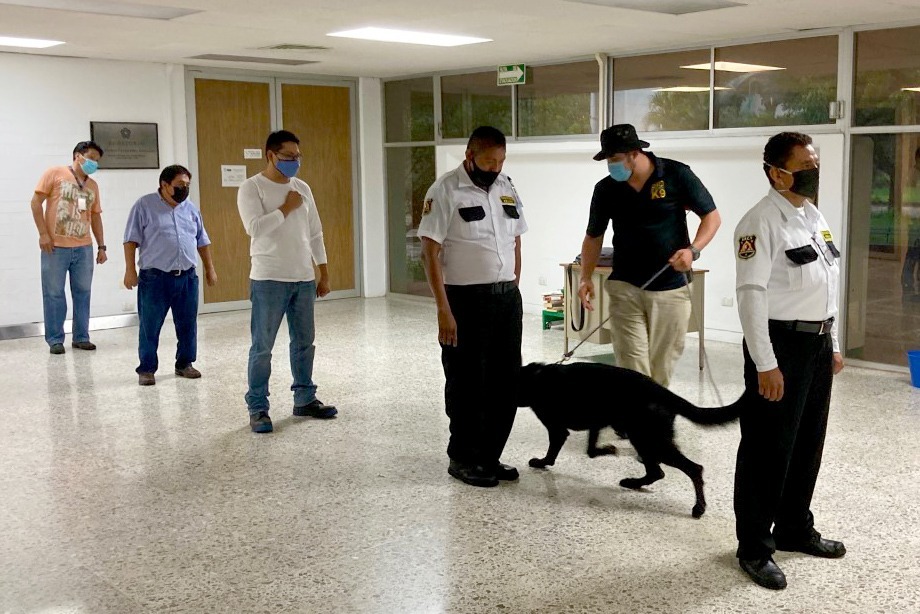HERMOSILLO, SONORA.- Covid-19 detection dogs become a quick and preliminary tool for pandemic control, with effectiveness of more than 90 percent, said the specialist from the Merida Unit of the Center for Research and Advanced Studies (Cinvestav)
He indicated that one way to face the pandemic caused by the new coronavirus is to apply various diagnostic methods such as immunological (antigens or antibodies) and molecular tests (chain reaction)
Therefore, it is necessary to have other options that are reliable, fast, and less expensive, especially in places with large concentrations of people.
He stated that a research group from Cinvestav – Mérida is working on characterizing and isolating volatile compounds, which become vapors or gases, present in the sweat of Covid-19 positive people, in order to develop a formulation that allows training dogs in a more efficient way for the detection of the disease in Mexico.
“Dogs are capable of detecting in a matter of seconds if a person has Covid-19, which makes them an affordable alternative to be used in industries, shopping centers, airports or at sporting events where many people go,” he said.
Vidal Martínez expressed that the researchers from the Mérida Unit, in collaboration with Juan Mancilla Tapia, a teacher in anthropology and director of the Obi-K19 Canine School, located in Hermosillo, Sonora, carry out this study as part of a Frontiers of Science Project of the National Council of Science and Technology (Conacyt), in which in addition to analyzing sweat compounds, trained dogs are put to sniff the samples and make detections in people who show symptoms or could be positive for coronavirus.

He highlighted that the data obtained indicate that dogs have a success rate of 71 to 85 to identify positive cases of Covid-19 from sweat samples, which is higher than the maximum detection limit of antigen tests, of 72 percent.
However, by identifying and isolating the volatile compounds present in the sweat of people with Covid-19, they can be added to the product used for canine training and achieve an effectiveness of 90 percent or greater, the researcher explained.
In addition, it was found that the dogs trained at the Obi-K19 school are able to identify the infection by the new coronavirus in people up to three days before it is detected through diagnostic methods and the first symptoms appear, so the use of the canines is most helpful to prevent the spread of the disease.
Regarding volatile compounds, the objective is to analyze 200 sweat samples (from armpits, neck, arms, and hands), one-half corresponding to negative cases and the other to positive ones, in order to obtain the pattern of those who are sick with Covid-19 and compare it with that of healthy people.
So far, around 50 samples have been collected and studied in which fatty acids, carbohydrates, sebum and compounds related to cholesterol have been found that could be used in the new formulation.
The research methodology consists of taking nasopharyngeal samples to carry out an RT-PCR test and check if it is a positive or negative case of COVID-19.
Also, sweat is collected with gauze, which, according to scientific literature, if it is from sick people, does not represent a risk of infection for humans or dogs.
A part of the sweat samples are placed in special containers and analyzed in the gas chromatograph. This apparatus heats the sample and detects the ions present; the information is compared with that of a database, which makes it possible to know what compounds it is.
The other half of sweat pads, both from people who tested positive and negative for the disease, are deposited in stainless steel salt shakers so that the canines can sniff and the researchers record the percentage of effectiveness with respect to detection.
For tests with people, a line is formed made up of healthy individuals and those who suspect they are sick, when the dogs detect a positive case they change their behavior, for example, they sit down and the handler recognizes these signals.
If two canines coincide in the detection, it is recommended to do an RT-PCR test in order to confirm the result, he concluded.
Source: Yucatan Ahora






